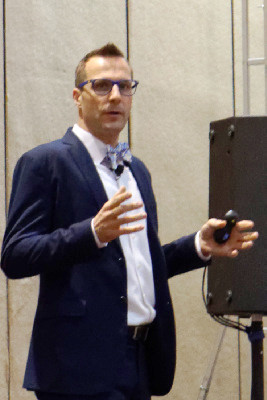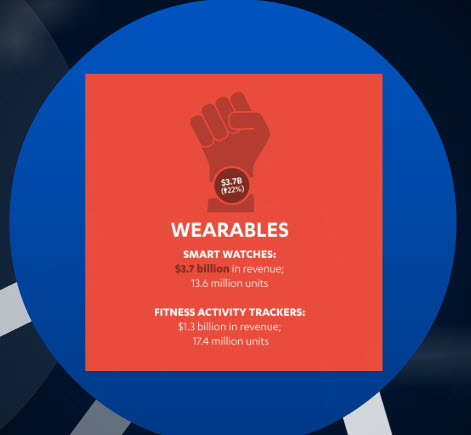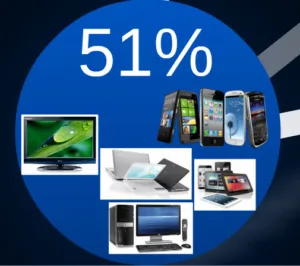 Dubravac of the CTA. Image:Meko LtdAs usual, the CES press events kicked off with a market briefing and “Technology Trends” talk by the CTA which runs CES. This year, the event was in a better location with room to breathe, which was something of a relief. In some previous years, the event has been held in tiny rooms with nowhere near enough space for the world’s press!
Dubravac of the CTA. Image:Meko LtdAs usual, the CES press events kicked off with a market briefing and “Technology Trends” talk by the CTA which runs CES. This year, the event was in a better location with room to breathe, which was something of a relief. In some previous years, the event has been held in tiny rooms with nowhere near enough space for the world’s press!
The first speaker was Shawn Dubravac, who is Chief Economist for the CTA and is a regular speaker on technology for the organisation. And as he is regularly, he said that he was excited about new technologies. (No doubt he would be especially happy about reliable wireless microphone technology as he had some trouble with his!).
DuBravac said that a reason for the change of name for his organisation from the CEA was especially to include consumer services such as AirBNB, Uber etc as well as electronics hardware.
He started by saying that this year’s CES covers 2.4 million square feet and is the largest in the 49 year history of the event with 150,000 visitors with almost a third coming from outside the US.
DuBravac said there are five key drivers of technology trends in the market.
- Ubiquitous computing – even in 2010 only 40% of US homes had a computer, now its nearly 90%
- Cheap digital storage has allowed the, effectively unlimited, storage of digital media.
- Connectivity – there are now more cell phone subscriptions than people in the US – an unexpected development even three years ago
- Proliferation of digital devices – the 1998 introduction of digital TV was the real start of the explosion and gradually all analogue devices have been replaced by digital equivalents and that transition is now basically over.
- A theme that DuBravac has talked about before is “the sensorisation of tech”
In the past, a lot of the focus in the technology business was on “what is possible” and technological achievement, but in the last couple of years there has been more focus, in his view, on what is technologically meaningful rather than what is possible. “What are the use case scenarios?” is the key question now, he said.
DuBravac also believes there is a significant inflection point this year (he seems to find one every year – Man Ed!). This year, 51% of the revenues in the categories that CTA tracks will come from smartphones, PCs, notebooks, TVs and tablets, but by next year, the proportion will be less than half. Market and revenue growth will come from nascent technologies.
At CES, the start up areas have become more important with 500 startups from 29 countries in 2016 in the Eureka Park Marketplace including 90+ “Indiegogo alumni”.
In 2016, DuBravac believes that three key new trends are visible:
- Ambient sensing
- Aggregated learning
- Maturing of nascent ecosystems
Ambient Sensing
The increasing adoption of sensors has been a long trend. It started more than ten years ago – for example an early adoption of sensors was in airbags and this was, essentially, hidden technology from the consumer point of view. Since then, the Wii remote (2006), the iPhone (2007), Kinect (2010) have arrived and the sensors have moved into the consumer space. DuBravac believes that most sensors are currently digitising analogue data and information.
Sensors and accelerometers have been used to measure the movements of babies, for example. The Intel Mimo, which tracks baby movement and health was released in 2014. Sensors have started to track in real time continuously.
Device and app makers are developing new “non-traditional” uses of data e.g. Whirlpool will link to Nest thermostat to optimise for a domestic device like a dishwasher. The data from the Nest is being used in ways that were not the original intention of the designer.
DuBravac said that he estimates that 20,000 new products would be launched at CES – with at least 15,000 (and maybe more) which will contain sensors of some kind. When the iPhone was launched, accelerometers to track orientation and movement cost around $7 per axis, but now that is less than 50cents, which has allowed much more use. He said that food sensors may be even be used to track calories.
Applications that can exploit these sensors include “Corner” which is a virtual “corner man” for a boxer that measures performance and condition and can give advice and feedback, as a traditional boxing “corner man” does. Sensium is another app that measures the “emotional response” to content and that can be used by the content creation business to better understand how consumers are reacting to content.
Many executives from the content, marketing and advertising industries come to CES. DuBravac estimated that there are 25,000 visitors interested in these topics at the show.
He believes that predictive customisation may “redefine recommendation” – can a system see and identify “light, heat and mood”?
DuBravac said that if a viewer of TV content is lying down, in the dark, in the cold and depressed then better recommendations might be made? (I’m not sure! Man. Ed.) This kind of technology will create predictions that deviate from history and are dependent on the environment. Systems may note the absence of things as well as the presence of things.
Voice Recognition & Aggregated Learning
 The “Word error rate” for voice recognition has changed dramatically, from 100% in 1995 when every word spoken might be missed. By 2013, the error rate had dropped to 23% and by 2015, the rate is around 5%. That’s a big improvement. There has been a huge rate of change over the last couple of years and that rate of change will continue and could enable one of the biggest changes in how we use and interact with technology. The connectivity and sharing of data is what has allowed the improvement – this is the idea of “aggregated learning”. Systems compare their errors to better understand mistakes and improve over time.
The “Word error rate” for voice recognition has changed dramatically, from 100% in 1995 when every word spoken might be missed. By 2013, the error rate had dropped to 23% and by 2015, the rate is around 5%. That’s a big improvement. There has been a huge rate of change over the last couple of years and that rate of change will continue and could enable one of the biggest changes in how we use and interact with technology. The connectivity and sharing of data is what has allowed the improvement – this is the idea of “aggregated learning”. Systems compare their errors to better understand mistakes and improve over time.
Google vehicles have now covered 1.6m kilometres – the same distance that an individual driver may cover in a lifetime. The learning across all vehicles is shared, so each new car gets the learning from earlier driving, rather than “starting again”.
200K sq ft of floor space at CES is devoted to automotive applications – that area would be a top 100 US trade show on its own, DuBravac said. GM & Lyft made an announcement on the day of the event that it would invest $500 million in Lyft and it was claimed that nine of the top ten US auto makers were at the show. GM & Lyft will work longer term on the provision of driverless rental cars.
Dubravac then went through the five levels of automation in cars. Level 1 is simple single functions such as cruise control and lane assist. Level 2 combines these, for example by lane assist working together with cruise control. At Level 3, there is some autonomous driving, but the control may return to the human, while at level 4, the car is in charge.
Level 3 just starting, but Level 4 is the long term future and DuBravac believes that the market will probably there by 2020, but adoption may be slow with around 1 million Level 4 cars per year by 2030. By 2045, most or all cars will be autonomous.
Maturing of nascent ecosystems
Another driver of the market is the maturing of ecosystems. Virtual reality is starting to develop and mature. The NYT distributed a lot of Google cardboard viewers at the end of last year. Kids really love VR (the kids in my family do! – Man. Ed.). DuBravac said that he has taken systems out to schools and there is a definite buzz about VR in education. He said that you will “never book cruises the same way again” – customers will want to use VR to really look around the ship and their cabin etc. VR will be an important advertising, marketing and entertainment experience.
1.2 million unit sales are forecast with revenues of $540 m for VR (440% up on 2015). Over a 100 companies at CES are working in the AR/VR environment. The market for 360 deg cameras will also grow. Market growth depends on a number of things coming together – but basically both content and hardware aligning.
UltraHD is growing well, from 1.4m TV sets in 2014 and with 65% growth this year to 13m sets. The market for smart TVs will be worth $13.8 billion in 2016. UltraHD Blu-ray is arriving now.
 Health and fitness will continue to grow, with more emphasis on on a more “holistic” health and wellness approach rather than just fitness. Smartwatches will grow to 13.6 million units with value of $3.7 billion, while the value of fitness trackers will be 174 million units and valued at $1.3 billion.
Health and fitness will continue to grow, with more emphasis on on a more “holistic” health and wellness approach rather than just fitness. Smartwatches will grow to 13.6 million units with value of $3.7 billion, while the value of fitness trackers will be 174 million units and valued at $1.3 billion.
Drones are a hot category with expected sales of 2.9 million units generating $953 million of revenues. New applications are arriving and new use case scenarios.
3D printers are “poised for growth over the next decade” (I think I’ve heard that a few times – Man. Ed.) The market in 2016 is for 179K units valued $152 million. Many K12 schools don’t have them yet, DuBravac said and that is a good opportunity. More work needs to be done in materials as well as printers. Young children are doing a lot in 3D space – Minecraft, VR etc etc and that will help them work with 3D very naturally, he believes.
Smart homes should deliver revenues of $1.2 billion and 8.9 million units. In the past, a smart home needed a lot of cabling – but no more, because of the spread of wireless technologies.

